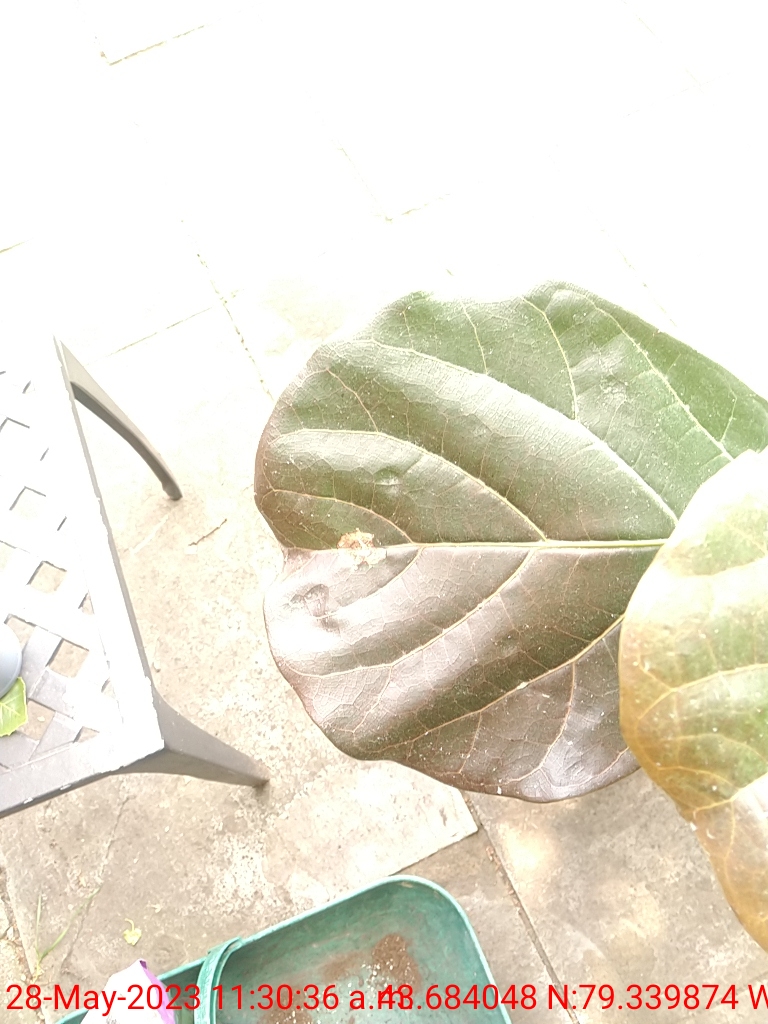
Rescued a false fig and have moved it from indoors to a semi shaded Patio. Leaves are turning brown, almost burnt looking. Can this. Plant be saved?
I’m sorry to hear that your Trilepisium madagascariense (false fig) is not adjusting to the outdoors. As you are in the GTA, the oddball weather we have been having (significant temperature changes from warm to cool days, to very cool nights) would have been a challenge for the plant to tolerate. You did not mention if the plant was doing well indoors before you moved it. You mentioned that you “rescued” it – which might suggest that it already had problems. However, for the purposes of this response, I’ll assume that the plant was healthy when it was placed outdoors.
It would be helpful to verify that the plant is indeed a false fig. It’s hard to tell from the single leaf in the photo you provide. In that photo, the leaf looks wide and is blunt at the tip. This is quite different from the slimmer elliptical leaves with prominent “driptips” that you’ll see in on-line photos and drawings of the false fig. For example, see the World of Agroforestry’s Trilepisium madagascariense. Your plant looks more like a fiddle-leaf fig (Ficus lyrata) – see The Spruce, How to Grow and Care for Fiddle-Leaf Fig. Leaves of this plant are (no surprise) shaped like a violin.
There is very little information available on-line about caring for the false fig, which grows in tropical and subtropical forests. However there is a lot of information regarding the fiddle-leaf fig that is readily available on-line. Regardless of which plant you have, both are considered tropical plants and the following general care recommendations apply.
As noted on the Toronto Master Gardeners website, May: Moving houseplants to outdoors, plants should be moved outdoors once nighttime temperatures are consistently above 10 degrees C. Once it’s time to move them outdoors, they should start out in a shady, protected area for 10-14 days before being put in their final location.
In general, plants have certain requirements:
- Soil
- If your plant has been in the same pot for some time, it may be time to repot. Use any good quality indoor potting mix or a tropical potting mix, one that drains well. Only repot when necessary – e.g., check if roots are trying to escape from the pot via drainage holes, or if the root ball has roots coiling around it.
- If there is no need to re-pot the plant, check for high salt or mineral levels (you can often see this as crusty white material on top of the soil) – if so, flush the soil until water seeps out of the pot. This is a good strategy to help prevent buildup of salts. Using distilled water or rainwater should avoid salt buildup.
- Watering
- Underwatering will cause plants to wilt, the leaves will brown then fall off.
- Overwatering can promote root rot, so the plant won’t be able to absorb nutrients and the leaves will brown and die.
- Water when the top 2.5 cm (1 inch) of soil is dry (test by sticking your finger into the soil).
- The fig likes lots of humidity – if not kept humid enough (e.g., by misting), the leaf tips could turn brown. From your photo, it appears that much of the leaf, not the tip, is affected, so I don’t believe this is currently a concern. Do keep in mind that misting throughout the summer is a good idea.
- Temperature
- Temperature fluctuations can affect the plant.
- For example, fiddle-leaf figs like temperatures between 15-24 degrees C –and don’t do well in areas where there are winds/drafts.
- Light
- The false fig grows in tropical forests, so can tolerate part shade and filtered light.
- The fiddle-leaf fig likes part shade, and filtered light.
- It sounds like you have sited the plant at or near the right spot, although perhaps a little more exposure to indirect light would help. Ensure it’s protected from the elements (wind etc).
- Direct sunlight can burn/scorch the leaves (and turn them brown)
- Fertilizer
- Fertilize during the growing season (May through September).
- There are lots of websites that advertise fertilizers specific for fiddle-leaf figs. However a good houseplant fertilizer should suffice.
- For the false fig, fertilization during the summer months, as noted above, would be appropriate.
From the information you provide, it’s not clear how many leaves are affected on the plant. You should be able to prune off several of the brown leaves without the plant losing vigour.
I’d suggest that you have patience with the plant, and try and nurture it to good health. All the best in keeping your plant green throughout the summer!

